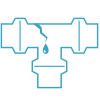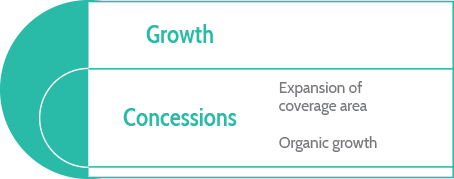Efficiency management
According to the National System of Sanitation Information (Sistema Nacional de Informações sobre Saneamento – SNIS), the average of all water lost in Brazil in 2015 was 36.7%. Instituto Trata Brasil estimates annual water waste in the country at 6.5 billion cubic meters, which is enough to fill six Cantareira systems, the largest water supply systems in the state of São Paulo and one of the largest in the world.
In recent years, Aegea has intensified efforts in order to contribute to lowering these indicators. In this sense, it is worth mentioning the Loss Management and Control (or GCP, its acronym in Portuguese) system, which coordinates integrated actions in the commercial and engineering areas for control of real losses (resulting from leaks) and apparent losses (resulting from fraud or imprecise measurements). Moreover, a Loss Management and Control Department was instituted in 2016, under the control of the Operations Division, whose job it is to inspect works and ongoing projects at concessionaires to adapt to the GCP system.
To make more assertive decisions, grounded on a solid base of data, telemetry systems and Operational Control Centers (Centros de Controle Operacional – CCO) are being adopted at concessionaires, allowing for remote monitoring of water and wastewater systems in real time. Águas Guariroba, Prolagos and the Nascentes do Xingu units at Barra do Garças, Primavera do Leste, Campo Verde, Sinop and Sorriso already rely on this sensor structure.
A pioneering technology in Brazil to identify leaks via satellite is also used at Águas Guariroba. This is the same methodology used to find water on other planets. Over the coming years, this innovation will be extended to the other units, starting with Prolagos.
Pillars of the GCP system

Management of system pressure
Maintenance of water pressure at appropriate levels to
reduce volume leaked and guarantee supply.

Active control of leaks
Actions and methodologies applied to find leaks hidden underground.

Speed and quality in repairs
Consolidated procedures to streamline solution of leaks and avoid reoccurrences.

Infrastructure management
Adoption of criteria to be monitored by concessionaires, such as heat maps, which are already used at some units and which indicate regions with a high rate of leaks.

Micromeasurement management
Micromeasurement1 is done when installing new connections and replacing water meters. This procedure is aimed at guaranteeing a lower rate of under registration2.

Detecting and resolving fraud
Oversight uses technologies that allow for efficiency and low costs in fighting fraud.
1. Measurement done at the supply system’s point of entry to the building.
2. Volume of water consumed, but not billed, by concessionaires.
As a result of investments made, it is worth noting the drop in the loss rate at units – especially at Águas de Timon and at the Nascentes do Xingu operation in Sinop (MT), which reached intervals of 16.6% in savings. New concessions usually have higher water loss rates, especially those located in regions where sanitation infrastructure is still precarious (the average for losses in the North region is around 73%), which consequently affects Aegea’s overall loss rate, which was 38.2% at the end of 2016.
In relation to optimization of internal processes, concessionaires count on support from the Aegea Administrative Center (CAA, its acronym in Portuguese), which is responsible for accounting, tax and auditing services; financial services; human resources; revenue security; information technology; and more. This concentration allows for qualification of information reported, stronger interaction and synergy between units and Company growth without increased per unit costs. Uniformization of systems and processes moreover allows for formatting of a standard model, which can be replicated anywhere in the country.






